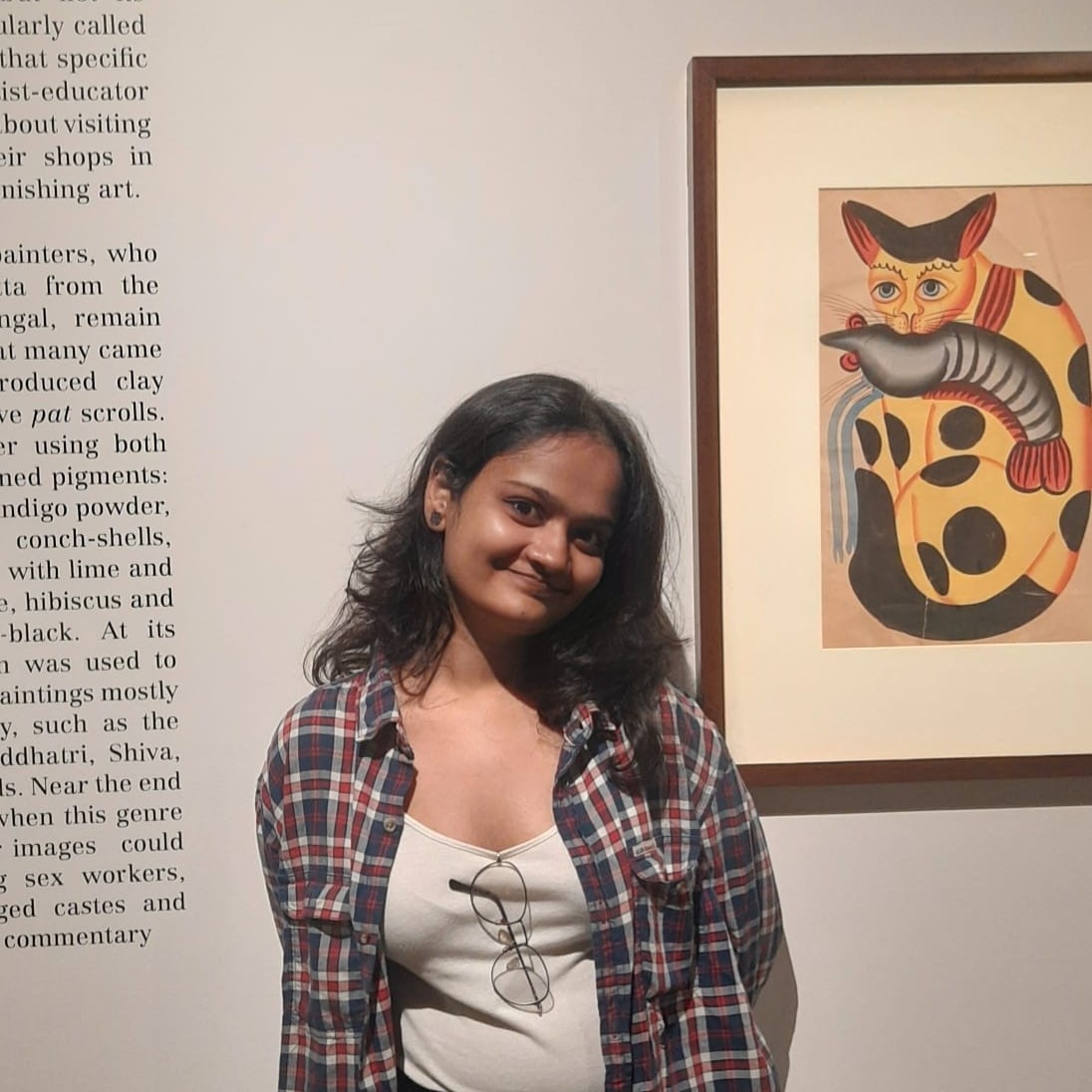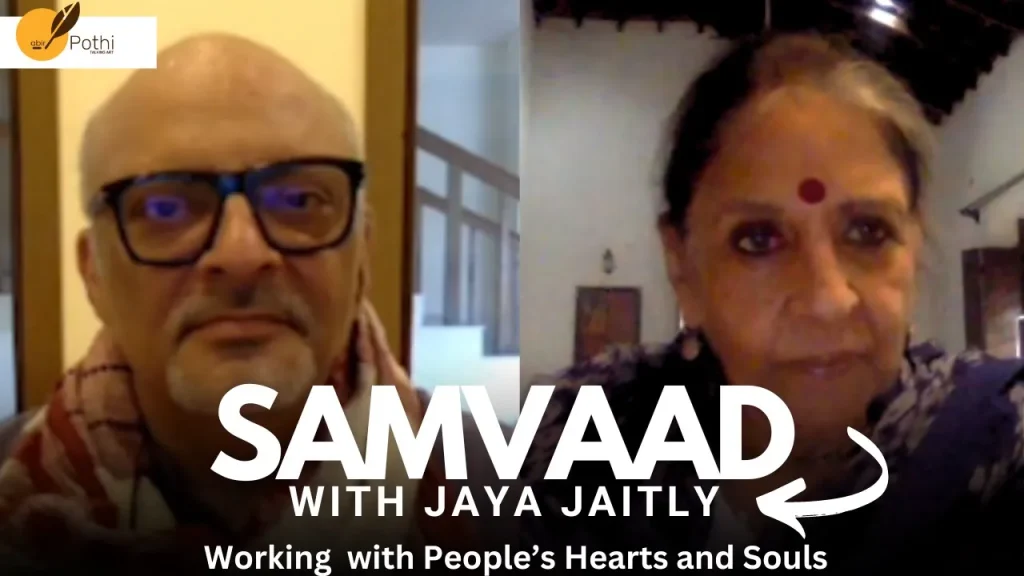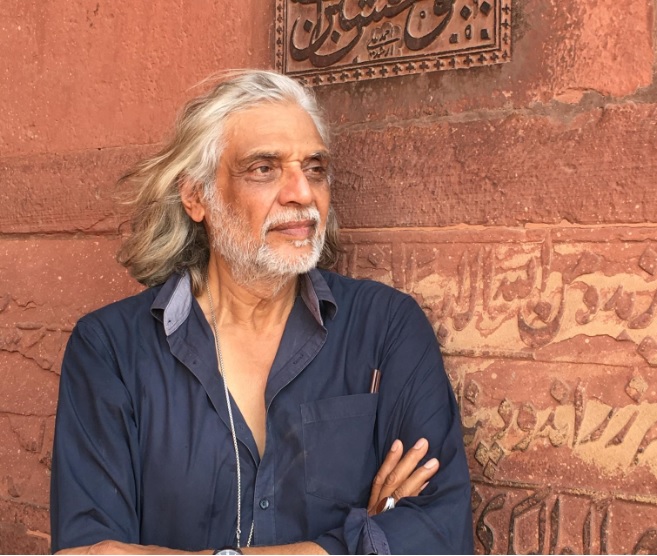Welcome to Samvaad, where art meets conversation, and inspiration knows no bounds. Here we engage in insightful conversations with eminent personalities from the art fraternity. Through Samvaad, Abir Pothi aims to create a platform for thought-provoking discussions, providing readers with an exclusive glimpse into the creative processes, inspirations, and experiences of these creative individuals. From curating groundbreaking exhibitions to pushing the boundaries of artistic expression, our interviews shed light on the diverse perspectives and contributions of these art luminaries. Samvaad is your ticket to connect with the visionaries who breathe life into the art world, offering unique insights and behind-the-scenes glimpses into their fascinating journeys.
This is Part 2 of the Samvaad is between Nidheesh Tyagi from Abir and Jaya Jaitly who is best known for her contributions to the promotion and preservation of Indian handicrafts and textiles. Jaitly has played a significant role in the development of the Indian handicraft sector and has been an advocate for the rights and welfare of artisans. She has been actively involved in various organisations working towards the empowerment of artisans and the promotion of traditional crafts. Jaya Jaitly has also written extensively on Indian crafts, culture, and social issues.
Nidheesh: True. So, how many lives would you have touched or brought to some kind of curated space in your journey of working with all the craftspeople of India? You must be a millionaire in your own right, touching a million lives, direct or indirectly because in a way of course it’s a beautiful thing.
Jaya: Well I can’t really assess because I don’t count I don’t work with statistics or facts or figures. I work with people’s hearts and souls. But, I remember once in Delhi Haat, I went and I was looking at some karigar (craftsperson) from Odisha, using some rope and making a stool. So I stopped and I said, “yeh bohot acche hain” (“these are very nice”) so they seemed to know me, I don’t remember what I had done with them, but just the fact that I had set up Delhi Haat, they said, “maam aapke karan 800 logon ko roti milta hai humare gaon mein” (Ma’am because of you, 800 people are fed in our village). So I found it such a lovely thing. I dont note up that okay that is 800 people. But the other point is that when I made Delhi Haat, hundred and fifty stores and you say that you rotate them twice a month, so that’s 300 people occupying. 300 people, would minimum each person would affect 5 lives of their own family aur iss gaon ka 800 (and 800 people from that village) and maybe 10-20 from cooperative society. so if you add all that and then our sales when we do our bazaar, our sales for 2 weeks has reached 6 and a half to 7 crore. And directly into their hands. So the money goes back. These are calculations which are off the back of my head neither am I a mathematician nor a statistician and neither do I want to impress people with these figures.
Nidheesh: No this is a real impact yeah.
Jaya: If the karigar is happy and smiles and keeps saying “Dilli Haat mein aana hai” (we want to come to Delhi-haat) then that’s a good thing. So this is how I assess. There’s another project which I’m very proud of which is called “Akshara”-crafting Indian scripts. Now karigars used to come and say to me “Hum gareeb hain, hum anpadh hain” (we are poor and illiterate) and be very dukhi (sad) about it. I don’t like anybody feeling like a victim and dukhi about it.
So I would get annoyed with them and I would say, “You have your own beautiful language, you have so many of your own mother tongues. look at this script. If you are anpadh, learn from your children’s school books how to write the alphabet in your own script. And what is your kala (skill) if you are weaving you are better than somebody who knows a computer because you are using your fingers in just the same way as they do So they are creating something on the screen, and you are creating something that somebody can tomorrow wear. So that is your ability, don’t undermine your own ability.”
But then I felt that let us gather craftspeople from every field, like wood carving, block printing, embroidery, metalwork, and stone, and give them all a little training in typography and calligraphy. So I got two eminent teachers to come for a week and teach them, so they learnt the word calligraphy, and they learnt how to carve a bamboo pen, to make a beautiful Akshar (alphabet). Then I taught them how to write an Akshar beautifully. So Kuch the k-kh (ABCs), how do you make it decorative? And then left them to do their own designs and then I said okay now when you go home apply this decorative design with your own language with what you have learnt, now you apply that design ability to your craft and all I want you to do is to do something when people see they say wow”. So I gave them that message and in quite some time-few months- we had 16 languages, 21 craft skills, and 14 languages spread across the country, like Hindi, Devanagari might be common to 2-3 states like that. And they created very beautiful things. And we had an exhibition called “Akshara” in which we showed all these in a very new light, not the, you know till then the craft was being shown by showing the thatched mud hut and makeup. Karigar sits there with the pagdi and looks as if he is still, his wife is making roti in the background, not like that. We did it in a very upgraded chic sort of way which could be worthy of every gallery.
And that was so popular that the govt at that time sent us to Egypt, to the UNESCO headquarters in Paris, which is very concerned about the extinction of languages around the world and we took some karigars with us who demonstrated all this.
With one of the karigars who does kalamkari, I went to his village in Sri kala hasti and he could work the computer and all so I sat him down, “Look at calligraphy in China, Korea, Japan and in the West Asian countries. Now this you do with your kalamkari, you draw the image of a bird but make that image contain telugu Akshar.” and he did such a beautiful job that his piece came out finally of his own accord of a huge tree of life, every leaf, every branch every bird every flower was made out of different phrases in telugu akshar. And sacred heart museum in Belgium bought that (piece)At that time for 1lakh rupees. So they took to calligraphy and I felt it was a new design vocabulary for them plus it was teaching them the value of their own languages and scripts, and teaching them the value of literacy and education. So all three combined and- so I feel that was a very successful project (for) which we then went to Singapore, we went to 7 places including India and other countries. We went to show Akshara. Ki India itna anpadh nahi hai. (That India is not so illiterate.) *chuckles*
Nidheesh: Talking about the scripts, How do we basically, this is also about getting things getting this taint or disappearing from our daily lives and rituals the way they used to be part of our lives. So how are we thinking about managing this whole wisdom and bringing it together and maybe also upgrading as you were talking about the calligraphy and Akshara? How does that happen, after that, we can talk about how art and design intertwined w craftspeople and how that’s changing the Indian Scene.
Jaya: well, just the Akshara project itself. It brought out many opportunities for the karigars to have their own thoughts. Otherwise, they were sitting dumb waiting for other people to tell them what to make/what to do. Now they again, as an example, plaque? There was a very nice block carving skill which is still there, and I said “Now you do calligraphy”. He was part of that small group and he said, “Kya likhun” (what do I write?) so I said, “I’m not going to tell you what to write. You have to activate your own mind so when you go home sit with your children, your father, your elder brother, and younger sister all, and you decide what would you like to carve on your work.” And he brought these most beautiful pieces, one said, “taalim insaan ko farsh se arsh tak uthata hai”(Education can take a man from ground to the sky) And the other one he made a beautiful door handle shaped like a peacock and within it he wrote that in urdu “those who enter are always welcome” like that. So it became a utilitarian decorative door handle with a lovely hidden message.
Nidheesh: With a philosophical kind of take on it yeah.
Jaya: so this is what I told him to do and now they go on their own track doing all these kinds of things. And one in Odisha, I got them to do a series of tota (parrot)images, tota is first in a cage, then a man comes along, releases the parrot from the cage and takes him along and each of the panels has the parrot holding one card of one alphabet in his mouth, and flying around with an alphabet. In the last one you see, that the man is actually one of our gaon ke astrologers (Village astrologers), who you know take those cards and then they say “Tota inka bhavishya kya hai” (Parrot, what does their future behold?) and the Tota picks up a little card, sort of like a Chinese fortune cookie.
And then I’m seeing that education gives you a livelihood, so educating the bird, gave the bird a livelihood, and the bird educated gave the man a useful livelihood. So that was another hidden story. And because I know the Indian culture of this astrologer and the tota from childhood, now you may probably not even see them, but one advantage of living long is you remember these childhood things and then so we replicated that in this painting. That painting is so popular people have used these panels as wedding cards so they’ve ordered 200 pieces of them. So like that, it just takes its own momentum. Anything which is replicable in a variety of ways I feel that I have succeeded in doing something new.
Nidheesh: I have also seen the Dastkar in your Mehrauli-
Jaya: Dastkar is a little different. Dastakar and the kisaan art in Mehrauli are not mine. Ours is called dastakaari art samiti. It’s more of a desi name. Because karigars must understand that they are a part of a sangathan and samiti. It’s not an NGO where any one or two people decide what to do. So we have a membership, they pay a membership fee we have annual meetings, we have internal elections and they decide what we will plan. “Kaun se jagah mein bazaar karna hai” (What place do they want to set up a market in). What kind of projects would you like to do, who has a problem with what place, this sort of thing.
So ours is a different sort of functioning organisation. Where it’s not so much the organisation that I’m trying to build but ideas and institutions which I try to create or set up or build. So Delhi Haat is one. It was made with my concept and the push of our organisation and the voice of the craftspeople. But other than 2 weeks a year where we pay full costs. It’s not ours, I’ve run it, I’ve never asked for a position there. It is for the whole country. Like we made craft maps. That was another big project of ours. Which was when I went to Thailand, they have Mary chandlers map of the markets of Bangkok. So electronic things where do you get, where do you get puppies for sale, where do you get handbags, tvs all of that? The map itself was handpainted very beautifully by some English lady who lives there. And I thought, “My gosh, if she can make such a beautiful map just of one city market. India has so much.”
Nidheesh: Absolutely.
Jaya: That takes me off on a 14 years project. Which I didn’t think I would want for 14 years. Ek karke aise ho gaya. (one by one it took place) I’ve covered all the states of India. And we had research people, them going to govt institutions, private institutions, the karigars, different places and finding out what are the little bit of culture and a little bit of process. What is the product? Where is made or sold? And then like a map showing how you get there. So it become like for tourists, for students, for anybody. And that each state govt they saw would say, “Haan-haan (yes yes) we also want for our state”. Other than Telangana which I have not been able to do after it divided up. We covered Jharkhand. We had done a bihar map but then we had to divide that up and make a Jharkhand. Uttarakhand got made like that. Chhattisgarh got made again like that. But I’m still waiting for the Telangana govt to ask me to do that map.
Transcribed by Vaishnavi Srivastava

Vaishnavi Srivastava is a learning writer, a keen researcher and a literature enthusiast. She is a Sub-editor at Abir Pothi.





